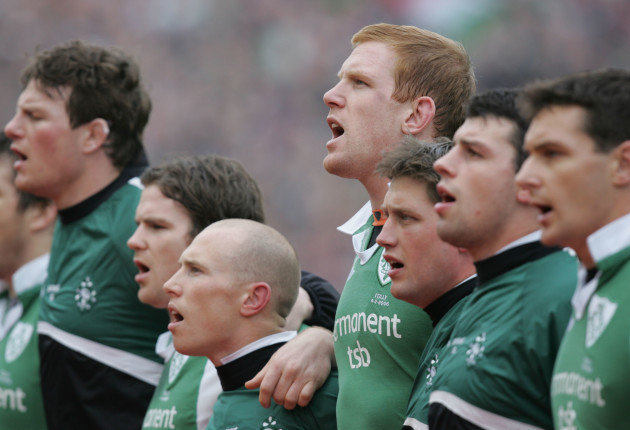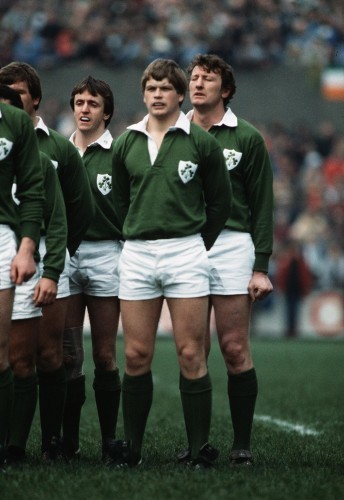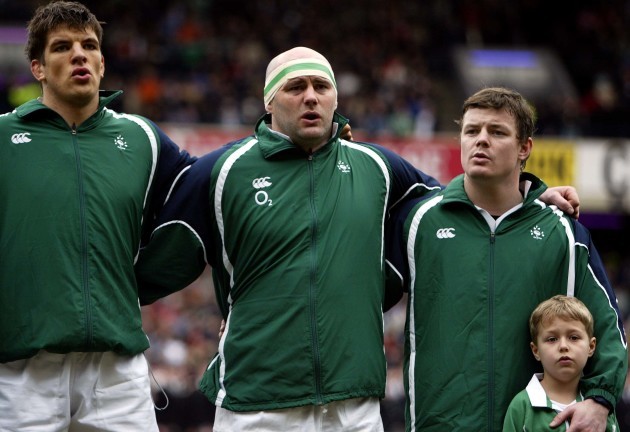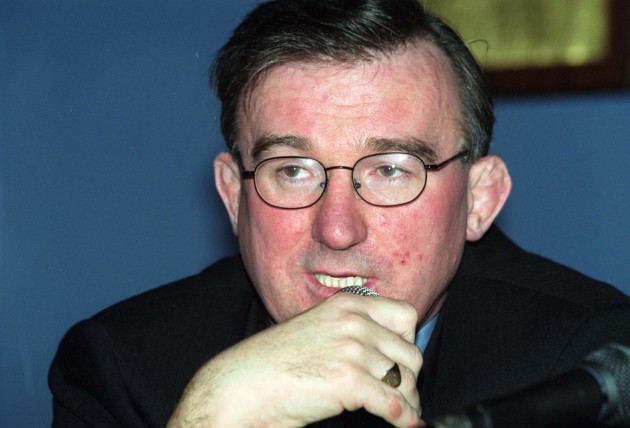ON THE DAY that Croke Park hosted a Six Nations game between Ireland and England in 2007, former rugby international Trevor Ringland approached a guard on his way to the stadium.
He wanted to know what pockets of the surrounding area were likely to see sectarian ructions, not because he wanted to avoid them, but because he wanted to see what would unfold.
What he discovered told him everything he needed to know about what that day would come to signify for the people of both islands.
“There was one guy there with a whole load of placards, but he was on his own,” Ringland tells The42.
“It showed to me a growing relaxation and a growing maturity in relationships between the people on this island and that is the way to go.
“And then you go into the ground and there was a good-natured atmosphere, the power and symbolism around the whole event, and I thought that this is what we want for the future — to have respect for the diversity on the island, the traditions on the island and between these islands.”
Elsewhere in the stands, a policeman and friend of Ringland’s was sitting in the stadium surrounded by ‘GAA men’, most of whom were from Munster. During their conversation, the subject of national anthems came up. God Save The Queen, Amhrán na bhFiann, and Ireland’s Call were on the playlist that day and in light of this, they reached a compromise.
“He turned around to them and said, ‘Right lads, what’s it gonna be? All three (songs) or none?’
“They all agreed to sing all three anthems and help each other with the different parts. He said the drink was flowing and the banter was great. It was just a very powerful day and we should never let go of the game. We should never let those who hate the most determine what we do.
“It just brings misery to the people of this island, whichever background they’re from. We should keep reminding ourselves of what’s possible.”
Ringland also sang the trio of anthems for the first time in his life, on a day which marked a poignant moment in Irish history following a century of healing.
Ringland has always enjoyed Ireland’s Call, and the symbolic power behind ‘the four proud provinces of Ireland.’ His former teammate Jim Glennon, however, has only in recent years come to find an appreciation for the song.
“It did nothing for me,” Glennon says.
“For me, in Lansdowne Road, the anthem was Amhrán na bhFiann. That was the anthem of my country and it was an extremely proud honour to stand for the national anthem with a green jersey on you.
“I just couldn’t feel the same pride for Ireland’s Call. In fact, I felt it diluted and undermined Amhrán na bhFiann. I saw the idea and I knew what they were trying to achieve, but it did absolutely nothing for me.
“I won’t say it grew on me, it still wouldn’t be my listening of choice, but I’d become used to it and I know now that it means an awful lot to an entire generation who’ve grown up with it.
“And as such, it is now representative of the Irish people who like and accept it. On that basis, I go along with that.”
During his time of indifference towards the song, Glennon kept his criticisms to himself and actively dodged the subject in the company of former teammates. He always sang it, particularly when he was the manager of the Ireland U19s squad that competed in the 1997 World Cup.
But on occasion, Glennon sat down during Ireland’s Call to demonstrate how he felt. It wasn’t until he saw a TV3 documentary on the anthem that he reconsidered his views.
I was just sitting at home by the fire, watching television and I didn’t know the documentary was on, it just appeared. I hadn’t any prior thinking about it. It just appeared and I saw my former teammates and I just saw it in a totally different context and a totally different light.
“I’m removed, to a large degree, from rugby. And it’s probably (through) my time in politics that I’ve become much more aware of the relationships between north and south. I was actively involved in a few projects during my time in politics that related to the north.”
Before the arrival of Ireland’s Call in 1995, Amhrán na bhFiann was the sole anthem that preceded Ireland’s rugby matches. Glennon recalls watching the Ulster contingent of the team standing diligently for a song which wasn’t the natural identifier of their homeland.
“They stood for Amhrán na bhFiann which, to a certain element up north, was absolute anathema. At that time, no other anthems were played at Lansdowne Road. The visiting anthem wasn’t played and it’s only in the last 12 or 15 years since the visiting anthem was played again in Lansdowne Road.”
The euphemistically-termed ’Troubles’ caused violent division throughout the island, but never penetrated the Irish rugby fraternity.
There was one occasion when it could have.
A few weeks before the 1987 World Cup, some of the Irish players were driving across the border to a training session in Dublin when a bomb exploded. The IRA had planted the bomb, with the intention of targeting Lord Justice Maurice Gibson, but the Irish players were caught in the blast.
Nigel Carr along with his teammates Philip Rainey and David Irwin survived the incident, but Carr’s injuries prevented him from ever playing rugby again.
On account of that tragic event, Amhrán na bhFiann was deemed an inappropriate choice of song for the World Cup. The Rose of Tralee was picked as the alternative track, which the players discovered when the music started playing ahead of their opening game against Wales.
It wasn’t a popular choice, and ultimately led to Phil Coulter writing Ireland’s Call in 1995.
Watching the documentary that night, Glennon relived the events which ended Carr’s rugby career, though this time with a different perspective.
“It really didn’t make a huge impact on us (at the time). We were totally focused on going to a World Cup four weeks later. Nigel never played again, which was a huge loss to the team and to Irish rugby.
“He was an outstanding rugby player and a crucial member of that team. We were a different team without him. Looking at it now, on more mature reflection, we took so much for granted down here as to what our colleagues were going through up there to play rugby.
“It was looking at the lads and how close they had come to death on that documentary and I think a lot, if not all, of my southern colleagues had missed (that) back in ’87.”
Ringland’s rugby career produced conflicting outcomes when it came to the Troubles. When he scored a try against England in Twickenham in the mid-80s, both wings of the Maze Prison cheered. A few years later, people from both nations called for him to be dropped after letting an English winger score a try.
Standing for Amhrán na bhFiann before rugby matches created similar problems for him.
“We stood out of respect and I learned very quickly that you never can get these things right,” he says.
“One person said to my mother after my first match that she should be very proud of me playing for Ireland and all that, but that I didn’t stand too straight for that song. Then walking down the street, another person said to tell me that I stood far too straight for the song. You realise that you can’t please everybody.”
Ringland grew up in west Belfast. His father was a member of the Royal Ulster Constabulary (RUC) who was later transferred to “The Glens of Antrim,” where he was appointed a sergeant.
Accounting for the threat coming from both sides of the border, his family routinely checked the underside of his car for traces of any explosives, and his parents kept a gun under their bed in the family quarters of the police station where they lived.
But despite carrying out those cautious measures, civil strife still found a way to interfere with their lives.
“There was one night when he was leaving the police station in North Belfast and came under attack by the IRA and he had to dive under the car,” he says. “He eventually made it back into the police station but he was stuck there with a two-hour gun battle between the IRA and the security forces.
“Meanwhile, my mother got a phone call from the local police station saying that loyalists were burning the policemen out of their houses. It just shows you sometimes the difficult position they were in.”
Ringland was aware of the fractured relations between Ireland and England, but rugby offered him a sanctuary from the ongoing conflict. It was through fostering relationships with players from all four provinces on the island, that he developed a hopeful vision for the future.
“The most dangerous place in the world in the 80s for a police officer was Northern Ireland. And yet, I found myself on an all-Ireland rugby team playing with people who I liked and enjoyed.
“We were good friends and there was a good atmosphere that was able to respect the British and Irishness of the whole island. There was an atmosphere of friendship and as we look to the future, I think that’s the dynamic that we have to make sure comes through rather than the dynamic of the past.”
Ireland’s Call provoked criticism from many when it was first introduced and the detractors still exist today. Glennon believes that the song is “a worthy reflection” of what “Irish rugby has contributed to the wider Irish society.”
For Ringland, it’s an appropriate tribute to those who suffered directly as a result of the Troubles.
“I think that people need to understand what it actually achieves. It is a song that people across the whole island can embrace and enjoy. It’s something that creates a sense of inclusion and respect for the new traditions across this island.
“That is something that should never in any way be played down or underestimated.
“When you think of those who lost loved ones during the Troubles — is it too much to ask that we allow some symbol like Ireland’s Call come through that actually builds relationships?
“Is that not the least we can do for those families who suffered so much, that we could at least start doing things a bit differently to the way that we’ve done in the past?
“We’ve tried the hate route, so why not try friendship? That’s a lot of what people who criticise Ireland’s Call don’t get.”
Subscribe to The42 Rugby Show podcast here:




